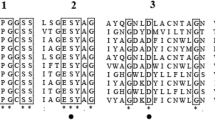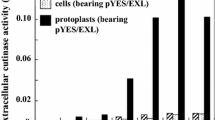Abstract
The genes encoding pro-carboxypeptidase Ys (pro-CPYs) from Saccharomyces cerevisiae and Hansenula polymorpha were cloned and expressed in Escherichia coli. Most of the expressed pro-CPY was present in the form of inclusion bodies, accounting for about 35% of the total cellular protein. The inclusion bodies solubilized in 6 M guanidinum chloride were renatured by dilution 1:60 into renaturation buffer. Further refolding and activation were followed by the addition of 60 μg ml−1 proteinase K into the diluted solution. The specific activities of in vitro activated S. cerevisiae and H. polymorpha CPYs were found to be similar, representing about 25% of that of native S. cerevisiae CPY.
Similar content being viewed by others
References
Bellu AR, Van Der Klei IJ, Rechinger KB, Yavuz M, Veenhuis M, Kiel JAKW (1999) Characterization of the Hansenula polymorpha CPY gene encoding carboxypeptidase Y. Yeast 15: 181–189.
Bradford MM (1976) A rapid and sensitive method for the quantitation of microgram quantities of protein utilizing the principle of protein-dye binding. Anal. Biochem. 72: 248–254.
Breddam K, Widmer F, Meldal M (1991) Amidation of growth hormone releasing factor (1–29) by serine carboxypeptidase catalyzed transpeptidation. Int. J. Peptide Protein Res. 37: 153–160.
Choi ES, Shon JH, Rhee SK (1994) Optimization of expression system using galactose inducible promoter for the production of anticoagulant hirudin in Saccharomyces cerevisiae. Appl. Microbiol. Biotechnol. 42: 587–594.
Hannig G, Makrides SC (1998) Strategies for optimizing heterologous protein expression in Escherichia coli. Trends Biotechnol. 16: 54–60.
Hasilik A, Tanner W (1978) Biosynthesis of the vacuolar yeast glycoprotein carboxypeptidase Y. Conversion of the precursor into the enzyme. Eur. J. Biochem. 85: 599–608.
Ichikawa K, Shiba Y, Jigami Y, Serizawa N (1993) Secretion and overproduction of carboxypeptidase Y by a Saccharomyces cerevisiae ssl1 mutant strain. Biosci. Biotech. Biochem. 57: 1686–1690.
Klionsky DJ, Herman PK, Emr SD (1990) The fungal vacuole: composition, function, and biogenesis. Microbiol. Rev. 54: 266–292.
Mechler B, Müller H, Wolf DH (1987) Maturation of vacuolar (lysosomal) enzymes in yeast: proteinase yscA and proteinase yscB are catalysts of the processing and activation event of carboxypeptidase yscY. EMBO J. 6: 2157–2163
Nielsen TL, Holmberg S, Petersen JGL (1990) Regulated overproduction and secretion of yeast carboxypeptidase Y. Appl. Microbiol. Biotechnol. 33: 307–312.
Peterson LM, Holmquist B, Bethune JL (1982) A unique activity assay for carboxypeptidase A in human serum. Anal. Biochem. 125: 420–426.
Piskur J, Kielland-Brandt MC (1993) Folding and secretion of Saccharomyces cerevisiae carboxypeptidase Y are influenced by fusion with short heterologous peptides. Biotechnol. Appl. Biochem. 18: 239–257.
Ramos C, Winther JR, Kielland-Brandt MC (1994) Requirement of the propeptide for in vivo formation of active yeast carboxypeptidase Y. J. Biol. Chem. 269: 7006–7012.
Raymond CK, Roberts CJ, Moore KE, Howald I, Stevens TH (1992) Biogenesis of the vacuole in Saccharomyces cerevisiae. Int. Rev. Cytol. 139: 59–120.
Sambrook J, Fritsch EF, Maniatis T (1989). Molecular Cloning: A Laboratory Manual, 2nd edn. Cold Spring Harbor, New York: Cold Spring Harbor Laboratory Press.
Stevens TH, Esmon B, Schekmen R (1982) Early stages in the yeast secretory pathway are required for transport of carboxypeptidase Y to the vacuole. Cell 30: 439–448.
Stevens TH, Rothman JH, Payne GS, Schekman R (1986) Gene dosage-dependent secretion of yeast vacuolar carboxypeptidase Y. J. Cell. Biol. 102: 1551–1557.
Valls LA, Winther JR, Stevens TH (1990) Yeast carboxypeptidase Y vacuolar targeting signal is defined by four propeptide amino acids. J. Cell. Biol. 111: 361–368.
Widmer F, Johansen JT (1979) Enzymatic peptide synthesis. Carboxypeptidase Y catalyzed formation of peptide bonds. Carlsberg Res. Commun. 44: 37–46.
Winther JR, Sorensen P (1991) Properties of carboxypeptidase Y provides a chaperone-like function as well as inhibition of the enzymatic activity. Proc. Natl. Acad. Sci. 88: 9330–9334.
Zhu X, Ohta Y, Jordan F, Inouye M (1989) Pro-sequence of subtilisin can quide the refolding of denatured subtilisin in an intermolecular process. Nature 339: 483–484.
Author information
Authors and Affiliations
Rights and permissions
About this article
Cite this article
Sun Hahm, M., Hoon Bae, J., Sung Choi, E. et al. In vitro activation of yeast pro-carboxypeptidase Y expressed as inclusion bodies in Escherichia coli . Biotechnology Letters 21, 881–885 (1999). https://doi.org/10.1023/A:1005506119165
Issue Date:
DOI: https://doi.org/10.1023/A:1005506119165




